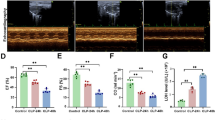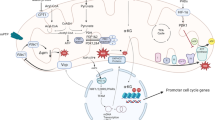Abstract
Myocardial ischemia-reperfusion injury is a medical problem occurring as damage to the myocardium following blood flow restoration after a critical period of coronary occlusion. Oxygen free radicals (OFR) are implicated in reperfusion injury after myocardial ischemia. The antioxidant enzyme, Cu, Zn-superoxide dismutase (Cu, Zn-SOD, also called SOD1) is one of the major means by which cells counteract the deleterious effects of OFR after ischemia. Recently, we reported that a PEP-1-SOD1 fusion protein was efficiently delivered into cultured cells and isolated rat hearts with ischemia-reperfusion injury. In the present study, we investigated the protective effects of the PEP-1-SOD1 fusion protein after ischemic insult. Immunofluorescecnce analysis revealed that the expressed and purified PEP-1-SOD1 fusion protein injected into rat tail veins was efficiently transduced into the myocardium with its native protein structure intact. When injected into Sprague-Dawley rat tail veins, the PEP-1- SOD1 fusion protein significantly attenuated myocardial ischemia-reperfusion damage; characterized by improving cardiac function of the left ventricle, decreasing infarct size, reducing the level of malondialdehyde (MDA), decreasing the release of creatine kinase (CK) and lactate dehydrogenase (LDH), and relieving cardiomyocyte apoptosis. These results suggest that the biologically active intact forms of PEP-1-SOD1 fusion protein will provide an efficient strategy for therapeutic delivery in various diseases related to SOD1 or to OFR.
Similar content being viewed by others
References
An, J.J., Lee, Y.P., Kim, S.Y., Lee, S.H., Kim, D.W., Lee, M.J., Jeong, M.S., Jang, S.H., Kang, J.H., Kwon, H.Y., et al. (2008). Transduction of familial amyotrophic lateral sclerosis-related mutant PEP-1-SOD proteins into neuronal cells. Mol. Cells 25, 55–63.
Choi, S.H., Kim, D.W., Kim, S.Y., An, J.J., Lee, S.H., Choi, H.S., Sohn, E.J., Hwang, S.I., Won, M.H., Kang, T.C., et al. (2005). Transduced human copper chaperone for Cu,Zn-SOD (PEP-1-CCS) protects against neuronal cell death. Mol. Cells 20, 401–408.
Choi, H.S., An, J.J., Kim, S.Y, Lee, S.H., Kim, D.W., Yoo, K.Y., Won, M.H., Kang, T.C., Kwon, HJ., Kang, J.H., et al. (2006). PEP-1-SOD fusion protein efficiently protects against paraquat-induced dopaminergic neuron damage in a Parkinson disease mouse model. Free Radie. Biol. Med. 41, 1058–1068.
Dalle-Donne, I., Rossi, R., Colombo, R., Giustarini, D., and Milzani, A. (2006). Biomarkers of oxidative damage in human disease. Clin. Chem. 52, 601–623.
Deshayes, S., Morris, M.C., Divita, G., and Heitz, F. (2005). Cell-penetrating peptides: tools for intracellular delivery of therapeutics. Cell Mol. Life Sei. 62, 1839–1849.
Dhalla, N.S., Temsah, R.M., and Netticadan, T. (2000). Role of oxidative stress in cardiovascular diseases. J. Hypertens. 18, 655–673.
Dong, X., Wang, J.N., Huang, Y.Z., Guo, L.Y., and Kong, X. (2007). Cell-penetrating peptide PEP-1-mediated transduction of enhanced green fluorescent protein into human umbilical vein endothelial cells. Zhongguo Yi Xue Ke Xue Yuan Xue Bao. 29, 93–97.
Droge, W. (2002). Free radicals in the physiological control of cell function. Physiol. Rev. 82, 47–95.
Eum, W.S., Kim, D.W., Hwang, I.K., Yoo, K.Y., Kang, T.C., Jang, S.H., Choi, H.S., Choi, S.H., Kim, Y.H., Kim, S.Y, et al. (2004). In vivo protein transduction: biologically active intact pep-1-superoxide dismutase fusion protein efficiently protects against ischemic insult. Free Radie. Biol. Med. 37, 1656–1669.
Fawell, S., Seery, J., Daikh, Y., Moore, C, Chen, LL, Pepinsky, B., and Barsoum, J. (1994). Tat-mediated delivery of heterologous proteins into cells. Proc. Natl. Acad. Sei. USA 91, 664–668.
Finkel, T. (2003). Oxidant signals and oxidative stress. Curr. Opin. Cell Biol. 15, 247–254
Frankel, A.D., and Pabo, CO. (1988). Cellular uptake of the tat protein from human immunodeficiency virus. Cell 55, 1189–1193.
Gustafsson, A.B., Sayen, M.R., Williams, S.D., Crow, M.T., and Gottlieb, R.A. (2002). TAT protein transduction into isolated perfused hearts: TAT-apoptosis repressor with caspase recruitment domain is cardioprotective. Circulation 106, 735–739.
Haunstetter, A., and Izumo, S. (1998). Apoptosis: basic mechanisms and implications for cardiovascular disease. Circ. Res. 82, 1111–1129.
Henriques, ST., Melo, M.N., and Castanho, MA. (2006). Cell-penetrating peptides and antimicrobial peptides: how different are they? Biochem. J. 399, 1–7.
Hwang, I.K, Eum, W.S., Yoo, K.Y, Cho, J.H., Kim, D.W., Choi, S.H., Kang, T.C., Kwon, O.S., Kang, J.H., Choi, S.Y., et al. (2005). Copper chaperone for Cu, Zn-SOD supplement potentiates the Cu,Zn-SOD function of neuroprotective effects against ischemic neuronal damage in the gerbil hippocampus. Free Radie. Biol. Med. 39, 392–402.
Jenner, P. (2003). Oxidative stress in Parkinson’s disease. Ann. Neurol. 53Suppl 3, S26–36.
Jin, LH., Bahn, J.H., Eum, W.S., Kwon, H.Y., Jang, S.H., Han, K.H., Kang, T.C., Won, M.H., Kang, J.H., Cho, S.W., et al. (2001). Transduction of human catalase mediated by an HIV-1 TAT protein basic domain and arginine-rich peptides into mammalian cells. Free Radie. Biol. Med. 31, 1509–1519.
Kumar, D., and Jugdutt, B.I. (2003). Apoptosis and oxidants in the heart. J. Lab. Clin. Med. 142, 288–297.
McCord, J.M., and Fridovich, I. (1969). Superoxide dismutase. An enzymic function for erythrocuprein (hemocuprein). J. Biol. Chem. 244, 6049–6055.
Morris, M.C., Depollier, J., Mery, J., Heitz, F., and Divita, G. (2001). A peptide carrier for the delivery of biologically active proteins into mammalian cells. Nat. Biotechnol. 19, 1173–1176.
Nathan, C. (2003). Specificity of a third kind: reactive oxygen and nitrogen intermediates in cell signaling. J. Clin. Invest. 111, 769–778.
Nelson, S.K., Bose, S.K., Grunwald, G.K., Myhill, P., and McCord, J.M. (2006). The induction of human superoxide dismutase and catalase in vivo: a fundamentally new approach to antioxidant therapy. Free Radie. Biol. Med. 40, 341–347.
Prochiantz, A. (2000). Messenger proteins: homeoproteins, TAT and others. Curr. Opin. Cell Biol. 12, 400–406.
Sayre, L.M., Smith, M.A., and Perry, G. (2001). Chemistry and biochemistry of oxidative stress in neurodegenerative disease. Curr. Med. Chem. 8, 721–738.
Schwarze, S.R., and Dowdy, S.F. (2000). In vivo protein transduction: intracellular delivery of biologically active proteins, compounds and DNA. Trends Pharmacol. Sei. 21, 45–48.
Simes, J., Furberg, OD., Braunwald, E., Davis, B.R., Ford, I., Tonkin, A., and Shepherd, J. (2000). Effects of pravastatin on mortality in patients with and without coronary heart disease across a broad range of cholesterol levels. The prospective pravastatin pooling project. Eur. Heart J. 23, 207–215.
Su, J., and Kwon, H. (2003). Simultaneous determination of 4-hydroxy-2-alkenals, lipid peroxidation toxic products. Food Addit. Contam. 20, 325–330.
Vives, E., Brodin, P., and Lebleu, B. (1997). A truncated HIV-1 Tat protein basic domain rapidly translocates through the plasma membrane and accumulates in the cell nucleus. J. Biol. Chem. 272, 16010–16017.
Wang, J.N., Ding, P., Huang, Y.Z., Luo, L.N., Guo, LY, Kong, X., and Shao, F. (2007). The protective effect of PEP-1-SOD1 preconditioning on hypoxia/reoxygenation injury in cultured human umbilical vein endothelial cells. Zhonghua Xin Xue Guan Bing ZaZhi. 35, 750–756.
Yellon, D.M., and Baxter, G.F. (2000). Protecting the ischaemicand reperfused myocardium in acute myocardial infarction: distant dream or near reality? Heart 83, 381–387
Author information
Authors and Affiliations
Corresponding author
About this article
Cite this article
Zhang, Ye., Wang, Jn., Tang, Jm. et al. In Vivo protein transduction: Delivery of PEP-1-SOD1 fusion protein into myocardium efficiently protects against ischemic insult. Mol Cells 27, 159–166 (2009). https://doi.org/10.1007/s10059-009-0020-4
Received:
Revised:
Accepted:
Published:
Issue Date:
DOI: https://doi.org/10.1007/s10059-009-0020-4




